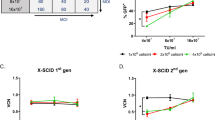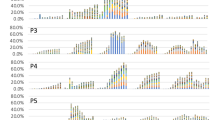Abstract
Patients with X-linked severe combined immunodeficiency (SCID-X1) were successfully cured following gene therapy with a gamma-retroviral vector (gRV) expressing the common gamma chain of the interleukin-2 receptor (IL2RG). However, 5 of 20 patients developed leukemia from activation of cellular proto-oncogenes by viral enhancers in the long-terminal repeats (LTR) of the integrated vector. These events prompted the design of a gRV vector with self-inactivating (SIN) LTRs to enhance vector safety. Herein we report on the production of a clinical-grade SIN IL2RG gRV pseudotyped with the Gibbon Ape Leukemia Virus envelope for a new gene therapy trial for SCID-X1, and highlight variables that were found to be critical for transfection-based large-scale SIN gRV production. Successful clinical production required careful selection of culture medium without pre-added glutamine, reduced exposure of packaging cells to cell-dissociation enzyme, and presence of cations in wash buffer. The clinical vector was high titer; transduced 68–70% normal human CD34+ cells, as determined by colony-forming unit assays and by xenotransplantation in immunodeficient NOD.CB17-Prkdcscid/J (nonobese diabetic/severe combined immunodeficiency (NOD/SCID)) and NOD.Cg-Prkdcscid Il2rgtm1Wjl/SzJ (NOD/SCID gamma (NSG))) mice; and resulted in the production of T cells in vitro from human SCID-X1 CD34+ cells. The vector was certified and released for the treatment of SCID-X1 in a multi-center international phase I/II trial.
This is a preview of subscription content, access via your institution
Access options
Subscribe to this journal
Receive 12 print issues and online access
$259.00 per year
only $21.58 per issue
Buy this article
- Purchase on Springer Link
- Instant access to full article PDF
Prices may be subject to local taxes which are calculated during checkout


Similar content being viewed by others
References
Noguchi M, Yi H, Rosenblatt HM, Filipovich AH, Adelstein S, Modi WS et al. Interleukin-2 receptor gamma chain mutation results in X-linked severe combined immunodeficiency in humans. Cell 1993; 73: 147–157.
Cavazzana-Calvo M, Hacein-Bey S, de Saint Basile G, Gross F, Yvon E, Nusbaum P et al. Gene therapy of human severe combined immunodeficiency (SCID)-X1 disease. Science 2000; 288: 669–672.
Hacein-Bey-Abina S, Le Deist F, Carlier F, Bouneaud C, Hue C, De Villartay JP et al. Sustained correction of X-linked severe combined immunodeficiency by ex vivo gene therapy. N Engl J Med 2002; 346: 1185–1193.
Gaspar HB, Parsley KL, Howe S, King D, Gilmour KC, Sinclair J et al. Gene therapy of X-linked severe combined immunodeficiency by use of a pseudotyped gammaretroviral vector. Lancet 2004; 364: 2181–2187.
Hacein-Bey-Abina S, von Kalle C, Schmidt M, Le Deist F, Wulffraat N, McIntyre E et al. A serious adverse event after successful gene therapy for X-linked severe combined immunodeficiency. N Engl J Med 2003; 348: 255–256.
Williams DA, Baum C . Medicine. Gene therapy--new challenges ahead. Science 2003; 302: 400–401.
Hacein-Bey-Abina S, Von Kalle C, Schmidt M, McCormack MP, Wulffraat N, Leboulch P et al. LMO2-associated clonal T cell proliferation in two patients after gene therapy for SCID-X1. Science 2003; 302: 415–419.
Howe SJ, Mansour MR, Schwarzwaelder K, Bartholomae C, Hubank M, Kempski H et al. Insertional mutagenesis combined with acquired somatic mutations causes leukemogenesis following gene therapy of SCID-X1 patients. J Clin Invest 2008; 118: 3143–3150.
Gaspar HB, Cooray S, Gilmour KC, Parsley KL, Adams S, Howe SJ et al. Long-term persistence of a polyclonal T cell repertoire after gene therapy for x-linked severe combined immunodeficiency. Sci Transl Med 2011; 3: 97ra79.
McCormack MP, Rabbitts TH . Activation of the T-cell oncogene LMO2 after gene therapy for X-linked severe combined immunodeficiency. N Engl J Med 2004; 350: 913–922.
Hacein-Bey-Abina S, Garrigue A, Wang GP, Soulier J, Lim A, Morillon E et al. Insertional oncogenesis in 4 patients after retrovirus-mediated gene therapy of SCID-X1. J Clin Invest 2008; 118: 3132–3142.
Baum C, Dullmann J, Li Z, Fehse B, Meyer J, Williams DA et al. Side effects of retroviral gene transfer into hematopoietic stem cells. Blood 2003; 101: 2099–2114.
Thornhill SI, Schambach A, Howe SJ, Ulaganathan M, Grassman E, Williams D et al. Self-inactivating gammaretroviral vectors for gene therapy of X-linked severe combined immunodeficiency. Mol Ther 2008; 16: 590–598.
Kraunus J, Schaumann DH, Meyer J, Modlich U, Fehse B, Brandenburg G et al. Self-inactivating retroviral vectors with improved RNA processing. Gene Therapy 2004; 11: 1568–1578.
Zychlinski D, Schambach A, Modlich U, Maetzig T, Meyer J, Grassman E et al. Physiological Promoters Reduce the Genotoxic Risk of Integrating Gene Vectors. Mol Ther 2008; 16: 718–725.
Schambach A, Swaney WS, van der Loo JCM . Design and production of retro- and lentiviral vectors for gene expression in hematopoietic cells. In: Baum C (ed). Method in Mol Biol 506. Humana Press: Totowa, NJ, 2009, pp 191–205.
van der Loo JC, Swaney WP, Grassman E, Terwilliger A, Higashimoto T, Schambach A et al. Scale-up and manufacturing of clinical-grade self-inactivating gamma-retroviral vectors by transient transfection. Gene Therapy 2012; 19: 246–254.
Tritsch GL, Moore GE . Spontaneous decomposition of glutamine in cell culture media. Exp Cell Res 1962; 28: 360–364.
Lin A, Agrawal P . Glutamine decomposition in DMEM: effect of pH and serum concentration. Biotechnol Lett 1988; 10: 695–698.
Heeneman S, Deutz NE, Buurman WA . The concentrations of glutamine and ammonia in commercially available cell culture media. J Immunol Methods 1993; 166: 85–91.
Nordling D, Kaiser A, Reeves L . Release testing of retroviral vectors and gene-modified cells. Methods Mol Biol 2009; 506: 265–279.
Schleef M, Schmidt T . Annimal-free production of ccc-supercoiled plasmids for research and clinical application. J Gene Med 2004; 6: S45–S53.
Villella AD, Yao J, Getty RR, Juliar BE, Yiannoutsos C, Hartwell JR et al. Real-time PCR: an effective tool for measuring transduction efficiency in human hematopoietic progenitor cells. Mol Ther 2005; 11: 483–491.
Sastry L, Xu Y, Cooper R, Pollok K, Cornetta K . Evaluation of plasmid DNA removal from lentiviral vectors by benzonase treatment. Hum Gene Ther 2004; 15: 221–226.
De Smedt M, Hoebeke I, Plum J . Human bone marrow CD34+ progenitor cells mature to T cells on OP9-DL1 stromal cell line without thymus microenvironment. Blood Cells Mol Dis 2004; 33: 227–232.
Acknowledgements
We thank the Translational Trials Development and Support Laboratory (TTDSL), Viral Vector Core and the Cell Processing and Manipulation Laboratory’s Normal Donor Repository of the Translational Core Laboratory (TCL) at Cincinnati Children’s Hospital Medical Center for qPCR analysis, vector titration and for providing human CD34+ cells, respectively. The Vector Production Facility is supported by Institutional funds from the Cincinnati Children’s Research Foundation. AS thanks the German Academic Exchange Service (DAAD), the European Union (FP7 program PERSIST) and the German Ministry for Research (BMBF project PIDNET.IFB-Tx) for their support. AJT acknowledges the Medical Research Council, The Wellcome Trust and Great Ormond Street Children’s Charity for their support. We thank Christopher Baum for his assistance with vector design and helpful discussions on scale-up.
Author information
Authors and Affiliations
Corresponding author
Ethics declarations
Competing interests
The authors declare no conflict of interest.
Additional information
Supplementary Information accompanies the paper on Gene Therapy website
Rights and permissions
About this article
Cite this article
van der Loo, J., Swaney, W., Grassman, E. et al. Critical Variables affecting clinical-grade production of the self-inactivating gamma-retroviral vector for the treatment of X-linked severe combined immunodeficiency. Gene Ther 19, 872–876 (2012). https://doi.org/10.1038/gt.2012.37
Received:
Revised:
Accepted:
Published:
Issue Date:
DOI: https://doi.org/10.1038/gt.2012.37
Keywords
This article is cited by
-
Simple viral/minimal piggyBac hybrid vectors for stable production of self-inactivating gamma-retroviruses
BMC Research Notes (2015)
-
Lentiviral vectors for the treatment of primary immunodeficiencies
Journal of Inherited Metabolic Disease (2014)



